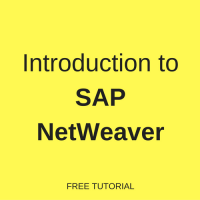 SAP NetWeaver (NW) is an integrated technology platform which can support various SAP applications such as ERP, CRM, BW, PI or SRM. It is the latest version of SAP architecture. Prior to this, the technology platform was Web Application Server and BASIS. SAP has changed the BASIS technology with the new technology; from BASIS to Web Application Server to indicate adaption of new technologies and the latest technology is NetWeaver. The technology has changed and keep changing, but the name of ‘BASIS’ is still using until now in SAP world.
SAP NetWeaver (NW) is an integrated technology platform which can support various SAP applications such as ERP, CRM, BW, PI or SRM. It is the latest version of SAP architecture. Prior to this, the technology platform was Web Application Server and BASIS. SAP has changed the BASIS technology with the new technology; from BASIS to Web Application Server to indicate adaption of new technologies and the latest technology is NetWeaver. The technology has changed and keep changing, but the name of ‘BASIS’ is still using until now in SAP world.
With SAP NetWeaver, people can access SAP data from any simple protocol up to the more complex protocol, i.e. on mobile solution because it is completely based on open technologies and standards.
SAP NetWeaver has various version started from NW 7.0, 7.0 EHP 1, 7.0 EHP 2, 7.0 EHP 3, 7.3, 7.3 EHP 1, 7.4 and the latest release is 7.5 (as of moment of writing).
SAP NetWeaver 7.5 supports new, latest and evolved technology trends like the Internet of Things (IoT), mobile and mobility solution, cloud, big data and analytics and fully responds to the growing customer needs and expectations being the foundation for easy and fast development of simple business applications with first class user experience.
SAP NetWeaver Components
There are three integration layers in SAP NetWeaver and one application platform. The integration layers are people, information and process integration. These are the core capabilities and main components of SAP NetWeaver technology.

People Integration
People integration ensures that users have information at hand and are able to process and analyze it very quickly. It mainly consists of SAP Enterprise Portal (SAP EP) and SAP Mobile Infrastructure (SAP MI).
Information Integration
Information Integration provides access to all information in an enterprise. Information integration consists of SAP Business Information Warehouse (SAP BW) , knowledge management, a component of the SAP Enterprise Portal, and Master Data Management (MDM).
Process Integration
Process Integration is used to streamline business processes across the company using the systems available. Process integration used XML data packages and workflow scenarios. However, the main component used in process integration is SAP Process Orchestration (PO).
Application platform
This is the SAP Web Application Server (WAS), which supports both the ABAP and JAVA runtime environments. Web applications and web services can be developed easily with the help of the application platform.
SAP NetWeaver Architecture
SAP System consists of:
- One database with a 3-character ID (SID = System ID)
- One or more instances that could each have their own host or could share hardware (multiple instances in one server)
SAP System Architecture with 3-tier architecture is illustrated below:

Presentation Layer
This layer is the interface between the SAP System and users. This is also known as front-end or client layer. SAP GUI client or Web GUI using browser provide a graphical user interface for accessing the SAP system.
Application Layer
The Application Layer consists of one or more application servers and one message server. Typically, only one application is installed or required but it depends on the SAP sizing and requirement where additional application is required. Regardless of how many application servers, there is only one message server for one SAP system and every single application server has a set of services to run SAP system.
Communication between application servers is via SAP message server. This message server services also important for passing the information while users connecting to SAP system. SAP message server is one of very important SAP services besides enqueue services where both are Single Point of Failure (SPOF) which must be made in high availability in clustered environment.
Database Layer
The Database Layer consists of a central database system containing all of the data in the SAP System. The database system has two components – the database management system (DBMS), and the data to be managed, which is within the actual database.
All SAP data is stored in the database. SAP support multiple database platforms, including HANA, Oracle, MS SQL Server, DB2, MaxDB, DB400 and ASE.
—
Did you like this tutorial? Have any questions or comments? We would love to hear your feedback in the comments section below. It’d be a big help for us, and hopefully it’s something we can address for you in improvement of our free SAP BASIS tutorials.
Navigation Links
Go to next lesson: SAP Application Server Instances
Go to overview of the course: Free SAP BASIS Training

What is true exactly about logical database Program ? Because i thought can access the hierarchical higher tables in my program, even though there is no table statements for the table.
Can you please clarify your question? It is not clear.
will you please suggest me a study center or institute for SAP Learning in Maharashtra.? I have Completed M.C.M, so Can I also do SAP Course?
Looking to learn SAP order to cash please contact me